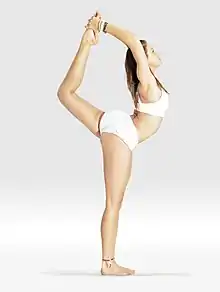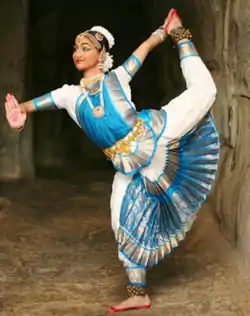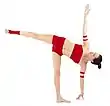Natarajasana
Natarajasana (Sanskrit: नटराजासन; IAST: Naṭarājāsana), Lord of the Dance Pose[1] or Dancer Pose[2] is a standing, balancing, back-bending asana in modern yoga as exercise.[3] It is derived from a pose in the classical Indian dance form Bharatnatyam, which is depicted in temple statues in the Nataraja Temple, Chidambaram.


Etymology and origins
The name comes from the Sanskrit words नट nata meaning "dancer", राज raja meaning "king",[4] and आसन asana meaning "posture" or "seat".[5] Nataraja is one of the names given to the Hindu God Shiva in his form as the cosmic dancer.[6]
The pose is depicted in 13th – 18th century Bharatnatyam dance statues of the Eastern Gopuram, Nataraja Temple, Chidambaram; some 20 different asanas are depicted, implying according to Ananda Bhavanani both an early origin for these poses and a cultural interchange between medieval hatha yoga and dance.[7]
Elliott Goldberg, on the other hand, observes that Natarajasana is not found in any medieval hatha yoga text, nor is it mentioned by any pre-20th century traveller to India, or found in artistic depictions of yoga such as the Sritattvanidhi or the Mahamandir near Jodhpur. Goldberg argues that the pose, like several others, was introduced into modern yoga by Krishnamacharya in the early 20th century, and taken up by his pupils such as B. K. S. Iyengar, who made the pose a signature of modern yoga; Goldberg suggests that Iyengar transmitted the pose also to Sivananda, as Iyengar sent him a complete photo album showing Iyengar in all his asanas.[8]
Description
This aesthetic, stretching and balancing asana develops concentration and grace;[9] it is used in the Indian classical dance form Bharatanatyam.[7] The actor Mariel Hemingway describes Natarajasana as "a beautiful pose with tremendous power", comparing the balance and tension in the arms and legs with an archery bow, and calling it "a very difficult pose to hold."[10]
The pose is entered from standing in Tadasana, bending one knee and stretching that foot back until it can be grasped with the hand on that side. The foot can then be extended back and up, arching the back and stretching out the other arm forwards.[11][1] For the full pose and a stronger stretch, reverse the rear arm by lifting it over the shoulder, and grasp the foot.[1]
Variations
Reaching up and back with both arms, elbows upwards, to grasp the rear foot gives a more intense pose.[2]
The pose can be modified by grasping a strap around the rear foot,[11] or by holding on to a support such as a wall or chair.[2]
See also
References
- "Lord of the Dance Pose". Yoga Journal. 28 August 2007.
- Swanson, Ann (2019). Science of yoga : understand the anatomy and physiology to perfect your practice. New York, New York: DK Publishing. pp. 114–117. ISBN 978-1-4654-7935-8. OCLC 1030608283.
- https://www.verywell.com/king-dancer-pose-natarajasana-pose-3567090
- Gerstein, Nancy (2008). Guiding Yoga's Light: Lessons for Yoga Teachers. Human Kinetics. pp. 118–. ISBN 978-0-7360-7428-5.
- Sinha, S. C. (1996). Dictionary of Philosophy. Anmol Publications. p. 18. ISBN 978-81-7041-293-9.
- Coomaraswamy, Ananda (1957). The Dance of Śiva: Fourteen Indian Essays. Sunwise Turn. OCLC 2155403.
- Bhavanani, Ananda Balayogi; Bhavanani, Devasena (2001). "BHARATANATYAM AND YOGA". Archived from the original on 23 October 2006.
He also points out that these [Bharatanatyam dance] stances are very similar to Yoga Asanas, and in the Gopuram walls at Chidambaram, at least twenty different classical Yoga Asanas are depicted by the dancers, including Dhanurasana, Chakrasana, Vrikshasana, Natarajasana, Trivikramasana, Ananda Tandavasana, Padmasana, Siddhasana, Kaka Asana, Vrishchikasana and others.
- Goldberg, Elliott (2016). The Path of Modern Yoga : the history of an embodied spiritual practice. Rochester, Vermont: Inner Traditions. pp. 223, 395–398. ISBN 978-1-62055-567-5. OCLC 926062252.
- Ramaswami, Srivatsa (2001). Yoga for the three stages of life: developing your practice as an art form, a physical therapy, and a guiding philosophy. Inner Traditions / Bear & Co. p. 186. ISBN 978-0-89281-820-4.
- Hemingway, Mariel (2004) [2002]. Finding My Balance: A Memoir with Yoga. Simon & Schuster. pp. 71–72. ISBN 978-0743264327.
- StPierre, Amber. "Troubleshooting King Dancer Pose". DoYouYoga. Retrieved 29 January 2019.
Further reading
- Iyengar, B. K. S. (1 October 2005). Illustrated Light On Yoga. HarperCollins. ISBN 978-81-7223-606-9. Retrieved 9 April 2011.
- Saraswati, Swami Satyananda (1 August 2003). Asana Pranayama Mudra Bandha. Nesma Books India. ISBN 978-81-86336-14-4. Retrieved 9 April 2011.
- Saraswati, Swami Satyananda (January 2004). A Systematic Course in the Ancient Tantric Techniques of Yoga and Kriya. Nesma Books India. ISBN 978-81-85787-08-4. Retrieved 9 April 2011.
_from_Jogapradipika_1830_(detail).jpg.webp)
